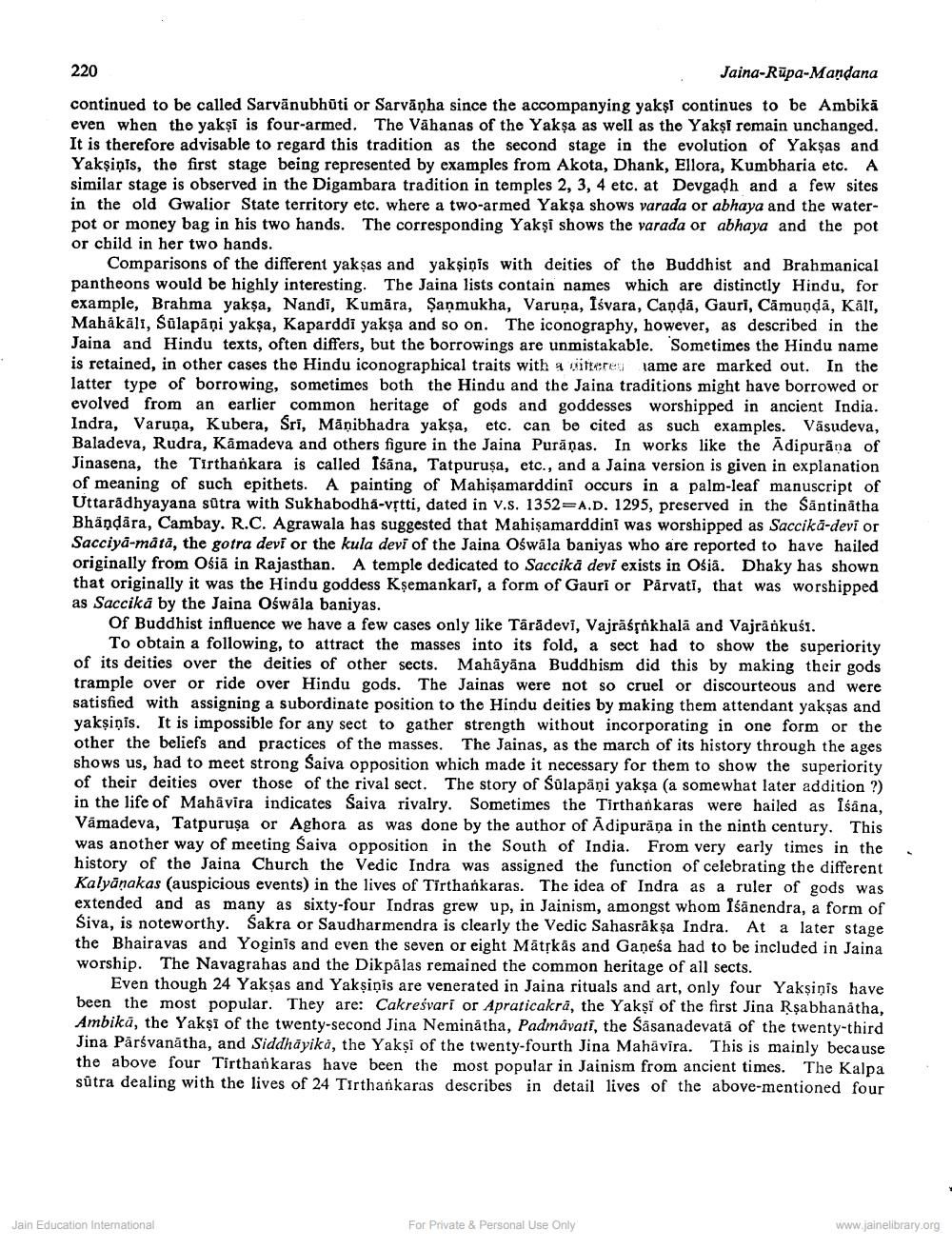________________
Jaina-Rupa-Mandana
continued to be called Sarvanubhuti or Sarvāņha since the accompanying yakşi continues to be Ambikā even when the yakṣi is four-armed. The Vahanas of the Yakṣa as well as the Yakşi remain unchanged. It is therefore advisable to regard this tradition as the second stage in the evolution of Yakṣas and Yakşiņis, the first stage being represented by examples from Akota, Dhank, Ellora, Kumbharia etc. A similar stage is observed in the Digambara tradition in temples 2, 3, 4 etc. at Devgadh and a few sites in the old Gwalior State territory etc. where a two-armed Yakşa shows varada or abhaya and the waterpot or money bag in his two hands. The corresponding Yakşi shows the varada or abhaya and the pot or child in her two hands.
220
Comparisons of the different yakṣas and yakṣiņis with deities of the Buddhist and Brahmanical pantheons would be highly interesting. The Jaina lists contain names which are distinctly Hindu, for example, Brahma yakṣa, Nandi, Kumāra, Şaṇmukha, Varuna, Isvara, Caṇḍā, Gauri, Cămuṇḍā, Käll, Mahākāli, Sūlapāņi yakṣa, Kaparddi yakṣa and so on. The iconography, however, as described in the Jaina and Hindu texts, often differs, but the borrowings are unmistakable. Sometimes the Hindu name is retained, in other cases the Hindu iconographical traits with a ditteres ame are marked out. In the latter type of borrowing, sometimes both the Hindu and the Jaina traditions might have borrowed or evolved from an earlier common heritage of gods and goddesses worshipped in ancient India. Indra, Varuna, Kubera, Śrī, Māṇibhadra yakṣa, etc. can be cited as such examples. Vasudeva, Baladeva, Rudra, Kamadeva and others figure in the Jaina Puranas. In works like the Adipurana of Jinasena, the Tirthankara is called Iśana, Tatpurușa, etc., and a Jaina version is given in explanation of meaning of such epithets. A painting of Mahişamarddini occurs in a palm-leaf manuscript of Uttaradhyayana sutra with Sukhabodha-vṛtti, dated in V.S. 1352=A.D. 1295, preserved in the Santinatha Bhaṇḍāra, Cambay. R.C. Agrawala has suggested that Mahişamarddini was worshipped as Saccikā-devi or Sacciya-mātā, the gotra devi or the kula devi of the Jaina Ośwāla baniyas who are reported to have hailed originally from Ośia in Rajasthan. A temple dedicated to Saccikā devi exists in Osia. Dhaky has shown that originally it was the Hindu goddess Kṣemankari, a form of Gauri or Parvati, that was worshipped as Saccikā by the Jaina Ośwâla baniyas.
Of Buddhist influence we have a few cases only like Târädevī, Vajräśrñkhalā and Vajränkusi.
To obtain a following, to attract the masses into its fold, a sect had to show the superiority of its deities over the deities of other sects. Mahayana Buddhism did this by making their gods trample over or ride over Hindu gods. The Jainas were not so cruel or discourteous and were satisfied with assigning a subordinate position to the Hindu deities by making them attendant yakṣas and yakṣiņis. It is impossible for any sect to gather strength without incorporating in one form or the other the beliefs and practices of the masses. The Jainas, as the march of its history through the ages shows us, had to meet strong Śaiva opposition which made it necessary for them to show the superiority of their deities over those of the rival sect. The story of Sulapāņi yakṣa (a somewhat later addition ?) in the life of Mahavira indicates Saiva rivalry. Sometimes the Tirthankaras were hailed as Isana, Vämadeva, Tatpuruşa or Aghora as was done by the author of Adipurana in the ninth century. This was another way of meeting Saiva opposition in the South of India. From very early times in the history of the Jaina Church the Vedic Indra was assigned the function of celebrating the different Kalyāṇakas (auspicious events) in the lives of Tirthankaras. The idea of Indra as a ruler of gods was extended and as many as sixty-four Indras grew up, in Jainism, amongst whom Iśānendra, a form of Śiva, is noteworthy. Sakra or Saudharmendra is clearly the Vedic Sahasraksa Indra. At a later stage the Bhairavas and Yoginis and even the seven or eight Mätṛkäs and Gaṇeśa had to be included in Jaina worship. The Navagrahas and the Dikpälas remained the common heritage of all sects.
Even though 24 Yakṣas and Yakṣiņis are venerated in Jaina rituals and art, only four Yaksinis have been the most popular. They are: Cakreśvari or Apraticakra, the Yakşi of the first Jina Ṛsabhanatha, Ambika, the Yakşi of the twenty-second Jina Neminatha, Padmavati, the Sasanadevata of the twenty-third Jina Parsvanatha, and Siddhayika, the Yakşi of the twenty-fourth Jina Mahavira. This is mainly because the above four Tirthankaras have been the most popular in Jainism from ancient times. The Kalpa sutra dealing with the lives of 24 Tirthankaras describes in detail lives of the above-mentioned four
Jain Education International
For Private & Personal Use Only
www.jainelibrary.org




